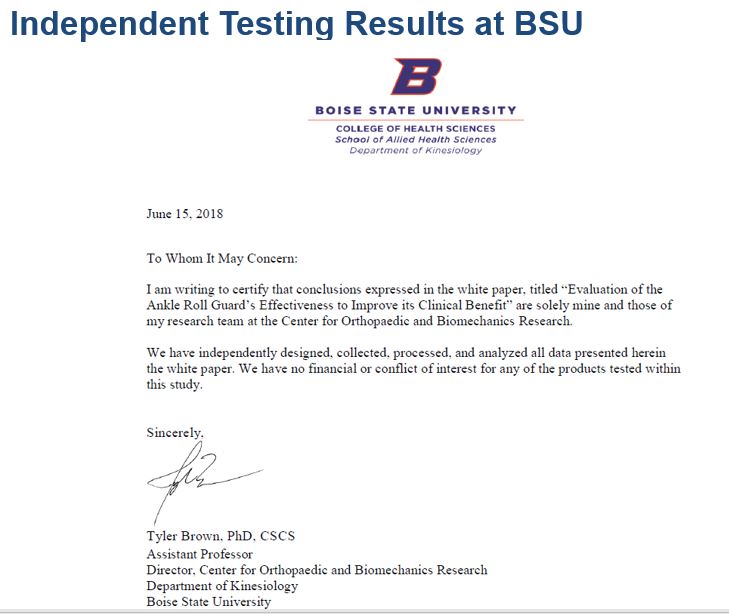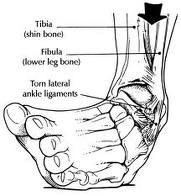Boise State University's Center for Orthopedic & Biomechanics Lab Conducted Extensive Independent Testing
Two peer reviewed white papers published in 2020:
- American Journal of Sports Medicine: Click Here to read report
- Journal of Sports Rehab: Click Here to read report
“Of all the devices (Ankle Roll Guard, Brace, Tape), only the Ankle Roll Guard appears to allow the user normal ankle motion (i.e. typical anatomical joint motion), while preventing excessive ankle inversion” ––Tyler Brown, PhD, CSCS, Director COBR
Key Conclusions:
- The Ankle Roll Guard provides similar prevention of excessive inversion as either the brace or tape, but without the mechanical restriction of the joint that reportedly limits physical performance when wearing ankle prophylactic devices. With the Ankle Roll Guard, participants exhibited more natural ankle motions (i.e. plantar & dorsi flexion) during both the sudden inversion event and vertical jump. This motion allowed the participants to perform better during the vertical jump with the Ankle Roll Guard as compared to the more restrictive brace and tape.
- The less restrictive ARG may make its use ideal during rehabilitation as it allows ankle plantar- and dorsiflexion motions, while preventing inversion related to injury.
- Prophylactics that restrict ankle plantarflexion motion may elicit knee biomechanical changes during a single-leg cut
- “Ideal ankle prophylactic design would not restrict typical joint motions, rather only prevent motions related to ligament damage and injury” Garrick JG, Requa RK. Role of external support in the prevention of ankle sprains. Am J Sports Med. 1973;5(5):200-203.

Ankle Sprain Statistics
- According to ACSM, 25,000 Americans suffer from an ankle sprain each day (9 million annually). Ankle sprains account for almost half of all sports injuries.
- More than 80 percent of ankle sprains are a result of inversion, or inward rolling, of the ankle.
- Sprained ankles have been estimated to constitute up to 30% of injuries seen in sports medicine clinics and are the most frequently seen musculoskeletal injury seen by primary care providers (Mahaffey D, Hilts M, Fields KB. Ankle and foot injuries in sports. Clin Fam Pract; 1999:1(1):233-50.)


Ankle Bracing & Taping Impact
- School of Kinesiology, Lakehead University study in the International Journal of Sports Science on the effect of wearing ankle braces on athletic performance. “Conclusions: These findings suggest that ankle bracing may have a negative impact on vertical jump height, regardless of the type of brace worn.” http://article.sapub.org/10.5923.j.sports.20160604.02.html
- “The use of the lace-up or semi-rigid ankle braces or taping negatively affected agility performance. We feel reasonably confident in our results because ankle braces restrict inversion and eversion ranges of motion.” Source: Ambegaonkar JP, Redmond C, Winter C, et al. Effects of ankle stabilizers on vertical jump, agility, and dynamic balance performance. Foot Ankle Spec 2011;4(6):366-372. Jatin P. Ambegaonkar, PhD, ATC, OT, CSCS, is associate professor of athletic training, codirector of the Sports Medicine Assessment, Research, and Testing (SMART) Laboratory, and coordinator of the Exercise, Fitness, and Health Promotion Program at George Mason University
- “When your foot/ankle are dependent on the support provided by the high tops and ankle braces, the muscles basically stop working as they no longer need to work. My ankles had gotten so weak from the braces, that they couldn’t support me at all.” Source: McLarty, Danny CSCS. “How to Develop Ankle Mobility”. Youth Basketball Online, 2013
- “A review of the literature (meta-analysis) found ankle supporting devices, including taping, semi-rigid braces, and lace-up braces, to have minimal effects on non-elite athletes, and others even found increased risk with brace use.” Source: May 2013 issue of the Clinical Journal of Sports Medicine; Epidemiology of US High School Sports-Related Ligamentous Ankle Injuries, 2005/06–2010/11


